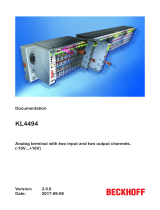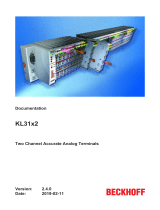
Content • iii
WAGO-I/O-SYSTEM 750
I/O Modules
Content
1.1 Scope ........................................................................................................4
2 I/O Modules.................................................................................................4
2.1 Analog Output Modules ...........................................................................4
2.1.1 750-562 [2 AO 0/+-10V DC 16 Bit] ...................................................4
2.1.1.1 View................................................................................................4
2.1.1.2 General Description ........................................................................ 4
2.1.1.3 Connecting Elements ......................................................................6
2.1.1.4 Indicators.........................................................................................6
2.1.1.5 Operating Elements.........................................................................6
2.1.1.6 Schematic Diagram.........................................................................7
2.1.1.7 Process
Image ................................................................................. 8
2.1.1.7.1 Process
Values ...........................................................................8
2.1.1.8 Function Description.....................................................................11
2.1.1.8.1 Step 1 – Reading Out X
IN
Process Data...................................11
2.1.1.8.2 Step 2 – Y
1
User Scaling.......................................................... 12
2.1.1.8.3 Step 3 – Y
2
Conversion of the Data Format............................. 13
2.1.1.8.4 Step 4 – Y
3
Limit Control......................................................... 13
2.1.1.8.5 Step 5 – Y
DAC
Calibration.........................................................14
2.1.1.9 Parameter Setting.......................................................................... 15
2.1.1.9.1 Register Assignment ................................................................15
2.1.1.9.2 Data Structures.........................................................................20
2.1.1.9.2.1 Configuration Concept ........................................................20
2.1.1.9.2.2 Switching the Operating Mode............................................20
2.1.1.9.2.3 Register Access and EEPROM Banks ................................20
2.1.1.9.3 Parameterization via WAGO-I/O-CHECK..............................22
2.1.1.9.3.1 User Interface ...................................................................... 22
2.1.1.9.4 Parameterization via GSD........................................................31
2.1.1.10 Technical Data ..............................................................................32
3 Use in Haz
ardous Environments .............................................................34
3.1
Marking Configuration Examples..........................................................35
3.1.1 Marking for Europe according to CENELEC and IEC .....................35
3.1.2
Marking for America according to NEC 500 ....................................38
3.2 Installation
Regulations.......................................................................... 39
3.2.1 Special Conditions for Safe Operation of the ATEX and IEC Ex (acc.
DEMKO 08 ATEX 142851X and IECEx PTB 07.0064).................. 40
3.2.2 Special conditions for safe use (ATEX Certificate TÜV 07 ATEX
554086 X) .......................................................................................... 41
3.2.3 Special conditions for safe use (IEC-Ex Certificate TUN 09.0001 X)43
3.2.4 ANSI/ISA 12.12.01 ........................................................................... 45






















